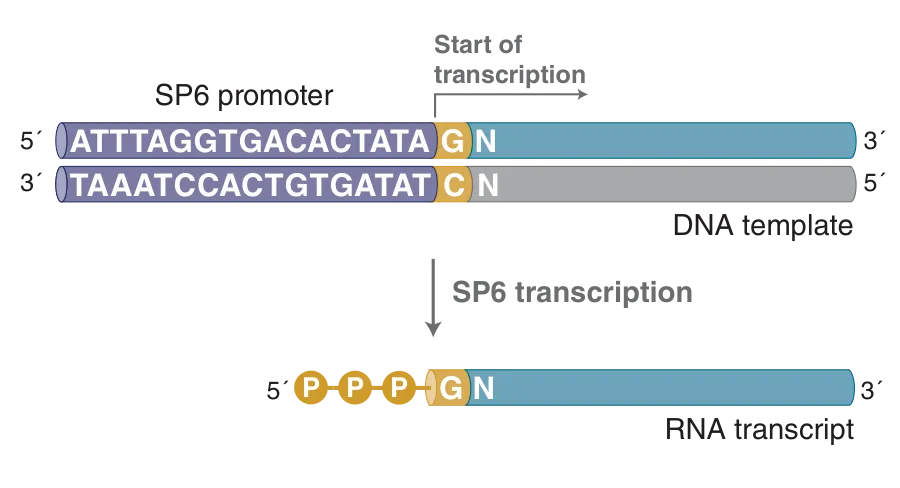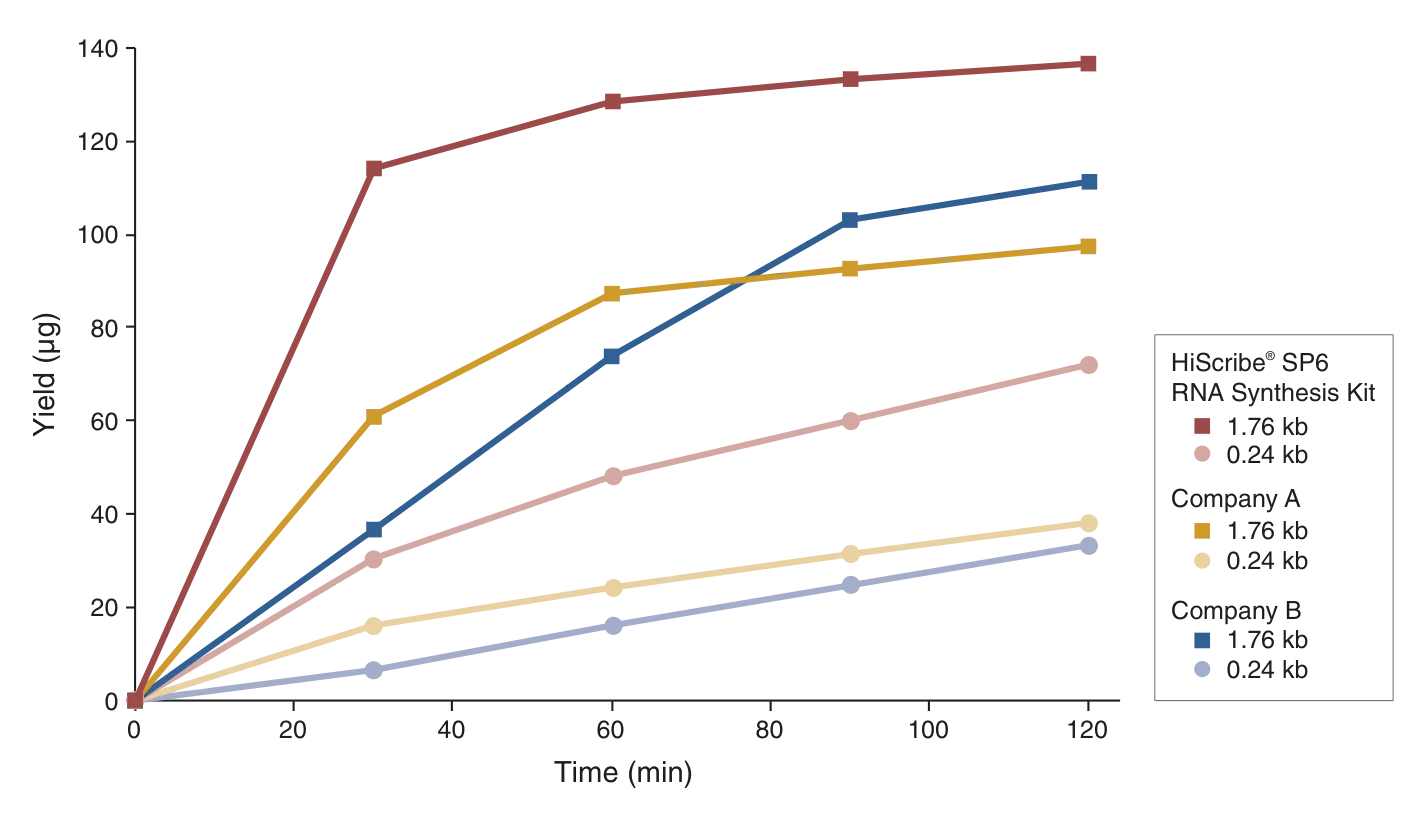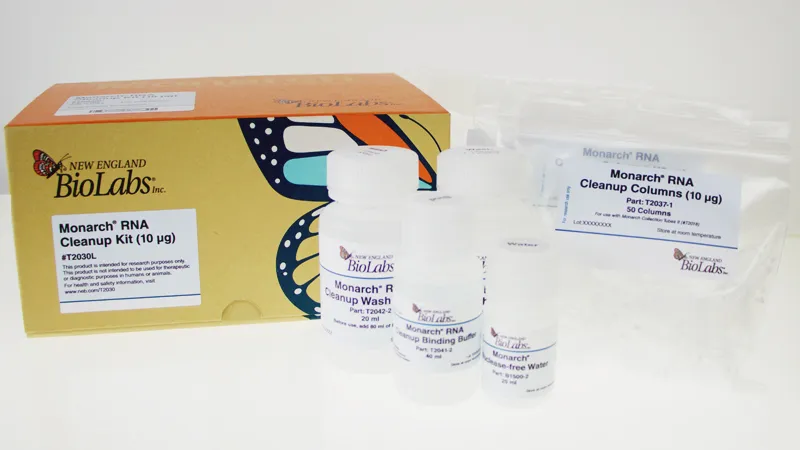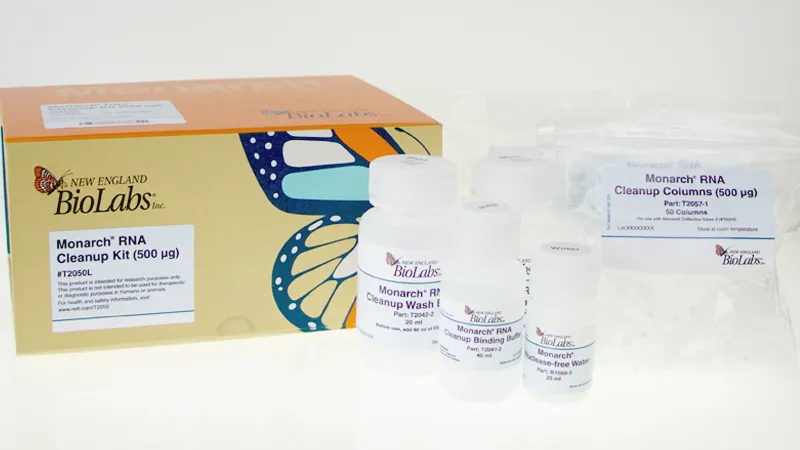HiScribe® SP6 RNA Synthesis Kit
Product information| Code | Name | Size | Quantity | Price | |
|---|---|---|---|---|---|
E2070S |
HiScribe SP6 RNA Synthesis Kit |
50 rxns | - | Unavailable in your region |
HiScribe® SP6 RNA Synthesis Kit
Now includes separate tube of DTT
Product Introduction
- Generate over 80 μg RNA per reaction
- Enables full substitution of NTPs for labeling and incorporation of modified bases including N1-Methyl-Pseudouridine-5’-Triphosphate (NEB #N0431), 5-Methyl-Cytidine-5’-Triphosphate (NEB #N0432), Pseudouridine-5’-Triphosphate (NEB #N0433) and 5-Methoxy-Uridine-5’-Triphosphate (NEB #N0434)
- Template removal and mRNA purification reagents included
- Linearized control template included for verification of RNA synthesis
- Getting ready to scale up RNA synthesis? Download our new technical note “Scaling of High-Yield In vitro Transcription Reactions for Linear Increase of RNA Production” for a generalized set of recommendations for synthesizing high yields of RNA.
| Catalog # | Size | Concentration |
|---|---|---|
| E2070S | 50 reactions |
Featured Videos
View Video Library- Product Information
- Protocols, Manuals & Usage
- FAQs & Troubleshooting
- Citations & Technical Literature
- Quality, Safety & Legal
- Other Products You May Be Interested In
Product Information
Description
The HiScribe SP6 RNA Synthesis Kit is designed for the in vitro transcription of RNA using SP6 RNA Polymerase. This kit is suitable for synthesis of high yield RNA transcripts and for incorporation of cap analogs (not included) or modified nucleotides (not included) to obtain capped, biotin-labeled or dye-labeled RNA. The kit is also capable of synthesizing high specific activity radiolabeled RNA for use as probes or targets.RNA synthesized from this kit is suitable for many applications including RNA structure and function studies, ribozyme biochemistry, probes for RNase protection or gel shift assays, hybridization-based blots, anti-sense RNA or RNAi experiments, microarray analysis, microinjection, sgRNA synthesis and in vitro translation studies.
This kit contains sufficient reagents for 50 reactions of 25 µl each. Each standard reaction yields ≥ 80 µg of RNA from 1 µg SP6 Control Template DNA. Each kit can yield ≥ 4 mg of RNA.


- This product is related to the following categories:
- RNA Capping,
- RNA Synthesis In vitro Transcription (IVT),
- Nucleotide Solutions for RNA,
Kit Components
Kit Components
The following reagents are supplied with this product:
| NEB # | Component Name | Component # | Stored at (°C) | Amount | Concentration | |||||||||||||||||||||||||||||||||||||||||||||||||||||||||||||||||||
|---|---|---|---|---|---|---|---|---|---|---|---|---|---|---|---|---|---|---|---|---|---|---|---|---|---|---|---|---|---|---|---|---|---|---|---|---|---|---|---|---|---|---|---|---|---|---|---|---|---|---|---|---|---|---|---|---|---|---|---|---|---|---|---|---|---|---|---|---|---|---|---|---|
| ||||||||||||||||||||||||||||||||||||||||||||||||||||||||||||||||||||||||
Properties & Usage
Materials Required but not Supplied
- Nuclease-free Water (NEB #B1500)
Related Products
Companion Products
- HiScribe®; T7 ARCA mRNA Kit
- HiScribe®; T7 ARCA mRNA Kit (with tailing)
- HiScribe® T7 High Yield RNA Synthesis Kit
- HiScribe®; T7 Quick High Yield RNA Synthesis Kit
- RNA Loading Dye, (2X)
- RNase Inhibitor, Human Placenta
- RNase Inhibitor, Murine
- DNase I (RNase-free)
- Q5® Hot Start High-Fidelity DNA Polymerase
- ssRNA Ladder
- Low Range ssRNA Ladder
- 3´-0-Me-m7G(5')ppp(5')G RNA Cap Structure Analog
- m7G(5')ppp(5')A RNA Cap Structure Analog
- G(5')ppp(5')A RNA Cap Structure Analog
- G(5')ppp(5')G RNA Cap Structure Analog
- m7G(5')ppp(5')G RNA Cap Structure Analog
- Vaccinia Capping System
- mRNA Cap 2 O Methyltransferase
- E. coli Poly(A) Polymerase
- Ribonucleotide Solution Set
- T3 RNA Polymerase
- T7 RNA Polymerase
- SP6 RNA Polymerase
- Uracil Glycosylase Inhibitor (UGI)
- N1-Methyl-Pseudouridine-5´-Triphosphate (N1-Methyl-Pseudo-UTP)
- 5-Methyl-Cytidine-5´-Triphosphate (5-Methyl-CTP)
- Pseudouridine-5´-Triphosphate (Pseudo-UTP)
- 5-Methoxy-Uridine-5´-Triphosphate (5-Methoxy-UTP)
Protocols, Manuals & Usage
Protocols
Manuals
The Product Manual includes details for how to use the product, as well as details of its formulation and quality controls.
Application Notes
FAQs & Troubleshooting
FAQs
- What is the promoter sequence for SP6 RNA Polymerase?
- Does transcription with SP6 RNA Polymerase require a primer?
- Does SP6 RNA Polymerase leave an extra base at the end of the transcript?
- Will SP6 RNA Polymerase initiate transcription from a single-stranded DNA template?
- Will SP6 RNA Polymerase work on an uncut plasmid?
- Can aberrant RNA be produced using SP6 RNA polymerase?
- Can kit components from the HiScribe SP6 RNA Synthesis Kit be substituted with SP6 RNA Polymerase and Reaction Buffer (NEB #M0207)?
- What is the sequence of the SP6 Control Template?
- Can I use the Monarch Spin RNA Cleanup Kits to cleanup my in vitro transcription (IVT) reaction?
- Are modified nucleotides included in the kit?
- Do I need to add DTT to the reaction?
Troubleshooting
Control Reaction
The SP6 control template is a linearized plasmid containing the Cypridina luciferase (CLuc) gene under the transcriptional control of the SP6 promoter. The size of the run-off transcript is 1.76 kb. The control reaction should yield ≥ 80 µg of RNA in 2 hours.
If the control reaction is not working, there may be technical problems during the reaction set up. Repeat the reaction by following the protocol carefully; take every precaution to avoid RNase contamination. Contact NEB for technical assistance.
The control plasmid pCLuc-SP6 sequence can be found within the DNA Sequences and Maps Tool. The pCLuc-SP6 control template is generated by linearizing the plasmid with XbaI.
Low Yield of Full-length RNA
If the transcription reaction with your template generates full-length RNA, but the yield is significantly lower than expected, it is possible that contaminants in the DNA template are inhibiting the RNA polymerase, or the DNA concentration may be incorrect. Alternatively, additional purification of DNA template may be required. Phenol:chloroform extraction is recommended (see template DNA preparation section).
Low Yield of Short Transcript
High yields of short transcripts (< 0.3 kb) are achieved by extending incubation time and increasing the amount of template. Incubation of reactions up to 16 hours (overnight) or using up to 2 μg of template will help to achieve maximum yield.
RNA Transcript Smearing on Denaturing Gel
If the RNA appears degraded (e.g. smeared) on a denaturing agarose or polyacrylamide gel, the DNA template is most likely contaminated with RNase. DNA templates contaminated with RNAse can affect the length and yield of RNA synthesized (a smear below the expected transcript length). If the plasmid DNA template is contaminated with RNase, perform phenol:chloroform extraction followed by ethanol precipitation. Dissolve the DNA in nuclease-free water (see template DNA preparation section).
RNA Transcript of Larger Size than Expected
If the RNA transcript appears larger than expected on a denaturing gel, template plasmid DNA may be incompletely digested. Even small amounts of circular DNA can produce large amounts of long transcripts. Check the template for complete digestion on an agarose gel compared to an uncut plasmid sample. If undigested plasmid is confirmed, repeat the restriction enzyme digestion.
Larger size bands may also be observed when the RNA transcript is not completely denatured due to the presence of strong secondary structure.
RNA Transcript of Smaller Size than Expected
If denaturing gel analysis shows the presence of smaller bands than expected, it is most likely due to premature termination by the polymerase. Some sequences which resemble the SP6 RNA Polymerase termination signal may cause premature termination. For GC-rich templates, or templates with secondary structure, incubation at 42°C may improve the yield of full-length transcript.
If premature termination of transcription is found in high specific activity radiolabeled RNA probe synthesis, increase the concentration of the “limiting nucleotide”. Additional unlabeled limiting NTP can be added to the reaction to increase the proportion of full-length transcript, however the improvement in yield of full-length product will compromise the specific activity of the probe.
Citations & Technical Literature
Citations
Additional Citations
Quality, Safety & Legal
Quality Assurance Statement
Quality Control tests are performed on each new lot of NEB product to meet the specifications designated for it. Specifications and individual lot data from the tests that are performed for this particular product can be found and downloaded on the Product Specification Sheet, Certificate of Analysis, data card or product manual. Further information regarding NEB product quality can be found here.Specifications
The Specification sheet is a document that includes the storage temperature, shelf life and the specifications designated for the product. The following file naming structure is used to name these document files: [Product Number]_[Size]_[Version]Certificate Of Analysis
The Certificate of Analysis (COA) is a signed document that includes the storage temperature, expiration date and quality controls for an individual lot. The following file naming structure is used to name these document files: [Product Number]_[Size]_[Version]_[Lot Number]- E2070S_v1_0021707
- E2070S_v1_10017244
- E2070S_v1_10045095
- E2070S_v1_10060491
- E2070S_v1_10071006
- E2070S_v1_10074628
- E2070S_v1_10088667
- E2070S_v1_10090009
- E2070S_v1_10095324
- E2070S_v1_10104431
- E2070S_v1_10108568
- E2070S_v1_10118030
- E2070S_v2_10145090
- E2070S_v2_10173058
- E2070S_v2_10208690
- E2070S_v3_10218932
- E2070S_v4_10228527
- E2070S_v4_10239807
- E2070S_v4_10249339
- E2070S_v4_10262395
- E2070S_v4_10272835
- E2070S_v4_10280515
- E2070S_v4_10299281
- E2070S_v4_10308842
Safety DataSheets
The following is a list of Safety Data Sheet (SDS) that apply to this product to help you use it safely.SP6 Reaction Buffer
SP6 RNA Polymerase Mix
SP6 Control Template
ATP (Tris)
GTP (Tris)
UTP (Tris)
CTP (Tris)
DNase I (RNase-free)
LiCl Solution
Dithiothreitol (DTT)
Legal and Disclaimers
Products and content are covered by one or more patents, trademarks and/or copyrights owned or controlled by New England Biolabs, Inc (NEB). The use of trademark symbols does not necessarily indicate that the name is trademarked in the country where it is being read; it indicates where the content was originally developed. The use of this product may require the buyer to obtain additional third-party intellectual property rights for certain applications. For more information, please email busdev@neb.com.This product is intended for research purposes only. This product is not intended to be used for therapeutic or diagnostic purposes in humans or animals.
New England Biolabs (NEB) is committed to practicing ethical science – we believe it is our job as researchers to ask the important questions that when answered will help preserve our quality of life and the world that we live in. However, this research should always be done in safe and ethical manner. Learn more.
Other Products You May Be Interested In
-

SP6 RNA Polymerase
-

Monarch® Spin RNA Cleanup Kit (50 μg)
-

ssRNA Ladder
-

DNase I-XT
-

DNase I (RNase-free)
-

RNA Loading Dye, (2X)
-

Faustovirus Capping Enzyme
-

Vaccinia Capping System
-

Monarch® Spin RNA Cleanup Kit (10 μg)
-

Monarch® Spin RNA Cleanup Kit (500 μg)
-

E. coli Poly(A) Polymerase
-

mRNA Cap 2´-O-Methyltransferase
-

3´-O-Me-m7G(5')ppp(5')G RNA Cap Structure Analog
-

G(5')ppp(5')A RNA Cap Structure Analog
-

G(5')ppp(5')G RNA Cap Structure Analog
-

m7G(5')ppp(5')G RNA Cap Structure Analog
-

m7G(5')ppp(5')A RNA Cap Structure Analog
The supporting documents available for this product can be downloaded below.
Protocol
RNA Synthesis Protocols (E2070)
Protocol
Evaluation of IVT Reaction Products
Protocol
Purification of IVT RNA
Protocol
RNA Synthesis Protocols (E2070)
Protocol
RNA Synthesis Protocols (E2070)
Protocol
RNA Synthesis Protocols (E2070)







